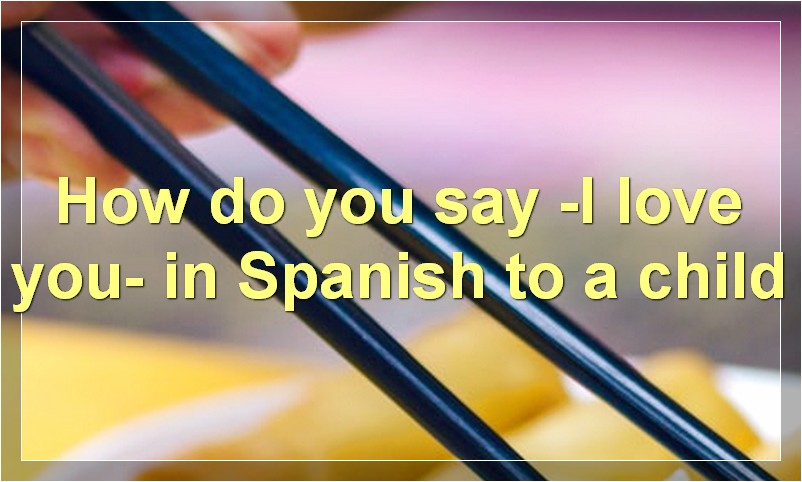If you want to impress your Spanish-speaking partner with a declaration of love, this guide will give you all the phrases you need.
How do you say “I love you” in Spanish
When it comes to expressing love, each language has its own unique way of doing so. In Spanish, there are multiple ways to say “I love you” depending on the context and the relationship between the speakers. Here are some of the most common ways to say “I love you” in Spanish.
“Te quiero” is probably the most common way to say “I love you” in Spanish. It can be used in both casual and more serious relationships. For example, you might use it with a romantic partner, family member, or close friend.
If you want to be a little more formal or show a deeper level of love, you can say “Te amo.” This phrase is typically used in more serious relationships, such as with a spouse or long-term partner.
If you want to express strong feelings of love and passion, you can say “Te adoro.” This phrase is often used in romantic relationships and can come across as quite intense.
For a more playful or lighthearted way of saying “I love you,” you can try “Me encantas.” This can be used in both romantic and platonic relationships.
If you want to show your affection for someone in a fun and friendly way, you can say “Eres mi sol” which means “You are my sun.”
No matter which phrase you choose, saying “I love you” in Spanish is a great way to show your affection for someone special in your life.
How do you say “I love you, Mom” in Spanish
In Spanish, the phrase “I love you, Mom” can be translated to “Te quiero, mamá”. This is a very simple, but heartfelt way of telling your mother that you care for her deeply. If you want to add a bit more emotion to this phrase, you could say “Te quiero mucho, mamá”, which translates to “I love you very much, Mom”.
Although “Te quiero” is the most common way to say “I love you” in Spanish, there are many other ways to express your love for your mother. For example, you could say “Eres mi vida”, which means “You are my life”. This is a powerful way to tell your mother that she means everything to you. Another option is to say “Sin ti no soy nada”, which translates to “Without you, I am nothing”. This phrase communicates that without your mother’s presence in your life, you would be lost and have nothing to live for.
No matter how you choose to say it, simply expressing your love and appreciation for your mother in Spanish will fill her heart with happiness. After all, there is no greater gift than knowing that your child loves and values you.
What is the Spanish translation of “I love you”
When it comes to expressing love in Spanish, there are a few different ways to say “I love you.” Here are some of the most common:
Te quiero
This is probably the most common way to say “I love you” in Spanish. It’s simple and straightforward, and can be used in almost any situation.
Te amo
This phrase is a bit more intense than “te quiero,” and is typically reserved for more serious relationships. If you’re in love with someone, this is the phrase you’d use.
Estoy enamorado/a de ti
This phrase translates to “I’m in love with you,” and is another way to express strong feelings of love.
There are also a few other phrases that can be used to express love in Spanish, though they are not as common as the ones above. Here are a few examples:
Contigo soy feliz – With you, I am happy
Eres mi vida – You are my life
No puedo vivir sin ti – I cannot live without you
Whichever phrase you choose, simply saying “I love you” in Spanish is a great way to show your loved one how much they mean to you.
How do you say “I love you” in Spanish to a man
When it comes to expressing love in Spanish, there are a few different ways to say “I love you” depending on your level of commitment. For example, if you’re saying “I love you” to your partner for the first time, you might say “Te quiero” or “Te amo.” If you’re saying “I love you” to a family member or friend, you can say “Te quiero” or “Te quiero mucho.”
Here are a few more examples of how to say “I love you” in Spanish:
-Estoy enamorado de ti: I’m in love with you
-Me encantas: I adore you / I love being with you
-Eres mi persona favorita: You’re my favorite person
-Siento mucho amor por ti: I feel a lot of love for you
How do you say “I love you” in Spanish to a woman
When it comes to expressing love, Spanish has a lot of options. In fact, there are so many ways to say “I love you” in Spanish that it can be overwhelming for native speakers, let alone learners of the language.
But don’t worry, we’re here to help. In this article, we’ll guide you through some of the most common ways to say “I love you” in Spanish, depending on the context and your relationship with the person you’re talking to.
We’ll start with the basics and work our way up to some more advanced expressions of love. By the end of this article, you’ll be able to tell your significant other “I love you” in Spanish like a native speaker.
Let’s get started!
How do you say “I love you” in Spanish to a child
“I love you” in Spanish to a child is “Te quiero.” This phrase is used to express affection and is often seen as a more heartfelt way to say “I love you” than its English translation.
When saying “Te quiero” to a child, it is important to be aware of the age of the child. For example, if the child is very young, it might be better to say “Te amo,” which is a more general term for “I love you.” However, if the child is a bit older and you want to show them that you care deeply for them, “Te quiero” is the perfect phrase.
Whatever age the child is, make sure to say “Te quiero” with a smile and look them in the eyes. This will help convey the sincerity of your words and show the child just how much they mean to you.
How do you say “I love you” in Spanish to a friend
“I love you” in Spanish is “te quiero” for a friend. This phrase is used to express affection, usually platonic love.
What is the difference between “Te quiero” and “Te amo”
When it comes to expressing love in Spanish, there are two very important phrases that you should know: “Te quiero” and “Te amo.” While these two phrases may seem similar, they actually have very different meanings. Here’s a look at the difference between “Te quiero” and “Te amo.”
“Te quiero” is the Spanish way of saying “I love you.” This phrase is typically used to express romantic love, but it can also be used to express platonic love. For example, you might say “Te quiero” to your partner, your child, or your best friend.
“Te amo,” on the other hand, is a stronger way of saying “I love you.” This phrase is usually reserved for expressing deep, romantic love. If you were to say “Te amo” to someone, it would be equivalent to saying “I love you” in English.
So, what’s the difference between these two phrases? Essentially, it boils down to the level of intensity. “Te quiero” is a more general expression of love, while “Te amo” is a deeper, more intense expression of love.
How can I say “I love you” in a romantic way in Spanish
When it comes to expressing love, there is no one-size-fits-all approach. The best way to say “I love you” in Spanish will vary depending on the relationship between the speaker and the person they are addressing. With that said, here are a few tips on how to say “I love you” in a romantic way in Spanish:
1. Be specific.
When telling your significant other that you love them, be as specific as possible. Generic statements like “Te quiero” (I love you) are nice, but they can lack the personal touch that makes them truly special. Instead, try phrases like “Te amo con todo mi corazón” (I love you with all my heart) or “Eres el amor de mi vida” (You’re the love of my life).
2. Use pet names.
Pet names are a great way to add an extra layer of meaning to your declaration of love. In Spanish, some common pet names for loved ones include “mi amor” (my love), “mi vida” (my life), and “cariño” (darling).
3. Write a love note.
There’s nothing quite as romantic as receiving a handwritten love note from your significant other. If you’re not sure what to write, try something simple like “Te amo mucho” (I love you very much) or “Eres todo para mí” (You mean everything to me).
4. Say it with flowers.
Flowers are always a welcome gesture, but they can be especially romantic when given as a declaration of love. In Spain, some of the most popular flowers to give include roses, lilies, and tulips.
5. Plan a special date night.
A special date night is the perfect opportunity to show your significant other how much you care about them. Whether you cook them dinner, take them dancing, or just spend time together talking and laughing, the important thing is that you make them feel loved and appreciated.
What are some other ways to say “I love you” in Spanish
When it comes to expressing love, Spanish has a lot to offer. Here are some of the most romantic things you can say in Spanish, whether you’re speaking to a significant other, close friend, or family member.
“Te quiero” is perhaps the most common way to say “I love you” in Spanish. It’s straightforward and easy to remember. However, there are many other ways to say “I love you” in Spanish that can add a bit of flair to your declaration.
For example, “Te amo” is a bit more intense than “Te quiero.” It conveys a deeper level of love and commitment. If you want to be extra romantic, try saying “Te adoro,” which means “I adore you.”
If you’re looking for something a bit more playful, you could say “Me encantas,” which means “I’m crazy about you.” This phrase is often used as a term of endearment between close friends and family members.
No matter how you say it, declaring your love in Spanish is sure to fill your loved one with happiness.





